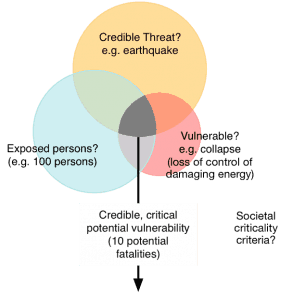Demonstrating Societal Due Diligence Using the Precautionary Approach
Arising from correspondence and discussion regarding earthquakes in New Zealand and bushfires in Victoria, R2A has been considering the possible application of the precautionary approach from a government regulatory perspective. The Venn diagram below is one result.

This implies three primary control options: eliminate the threat, remove exposed persons, or reduce the vulnerability. All are viable options with different perspectives but typically fall into different ‘control’ domains. For example, the ‘exposed persons’ issue is usually a land use planning matter generally being the responsibility of local government. The issue of vulnerability is usually an engineering concern the responsibility for which mostly falls to owners of exposed facilities. The nature of the threat is more a scientific matter and typically the concern of research organisations.
This makes the grey intersection a complex disciplinary patch, with overlapping responsibilities for government agencies, research and engineering organisations and with all the confusions as to whether the ‘hazard’ is a personal problem and the responsibility of individual owners, or a societal problem to be addressed with community resources.
Perhaps the most useful observation from this model to date is that the elimination of persons from an exposed area, a quite natural government response, is only one of three possibilities. The model above suggests that the optimal societal course of action is likely to be a mixture of the three control domains.
